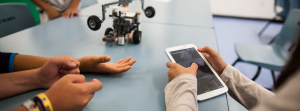Nowadays, it’s rare to find a student without some type of technology in their hands. There’s lots of talk about the importance of our students having digital citizenship and 21st-century skills, but if they’re getting ample exposure to their devices outside of the classroom, is there even a need to be using them in the classroom? Is it too much, or do our students actually benefit from extra screen time?
5 ways technology benefits education

1. Plenty of opportunities
In a time when education budgets are tight, implementing online and digital learning opportunities can help reduce operational costs without taking up more time or compromising the quality or consistency of instruction delivered.
We can use technology with flipped learning, formative assessments, and personalized development to help supplement lectures and curriculum with relevant content and experiential learning.
Technology also plays a huge role in increasing our students’ productivity by giving them the tools they need to be more successful as well as motivators and rewards when they perform well. This in return reduces wasted time, energy, and money while encouraging and rewarding hard work.
It’s not just for students, either — technology can be a huge asset for teachers to help increase educational achievement, especially when other resources and funds are limited (or, in some cases, nonexistent).

2. Digital literacy
As technology becomes ever-present in our lives, it’s essential that our students have opportunities to develop strong technology and digital literacy skills. They can practice these skills through online learning, while still focusing on core academic subjects and without the need for extra funds.
At the same time that our students are meeting their curriculum objectives, we are allowing them to gain skills needed to become competitive once they pursue higher education and enter the workforce.
Technology and online learning can also equip teachers with real-time analytics so they can better track students and identify those who need extra support. This is particularly useful for differentiating instruction and tending to the individual needs of each student. Instructors can easily share these reports with parents and administration, saving them precious time.
Again, technology benefits everyone, not just students — it can provide embedded professional development and training materials to help instructors keep pace with current trends in the changing landscape of education.

3. Increased exposure to STEM
STEM-based learning includes science, technology, engineering, and mathematics lessons that prepare students for lifelong success. Studies have shown that students’ problem-solving abilities, creativity, and innovation all increase when integrating technology with core content areas.
Students proficient with STEM are logical thinkers who are able to develop solutions and answer complex questions to reach their goals. By engaging our students in STEM education through technology, we can help them meet the increasingly technical and rigorous demands of the 21st century.
Unfortunately, there isn’t just one magical solution that will effectively prepare students for the future. However, there does need to be a focus on STEM—whether that’s through applied sciences, mathematics and physics, or even computer science curriculum.

4. Improved communication skills
There’s no use in denying reality — technology has become a core part of our social lives, especially among young children and adults. Students can practice communication skills daily through personal exchanges, online forums, and various social media. But without technology, their world is much smaller and less interconnected than it can be.
With the world being so large and diverse, engaging with peers through email or virtually collaborating on an assignment with others outside of the classroom, or even outside the country, helps students become more knowledgeable and well-versed in teamwork. For example, technology could help students in a foreign language class have regular virtual meetings with students in that foreign country to refine their speaking and listening skills.
By adding a web-enabled dimension to the classroom, educators can enhance comprehension while giving students new perspectives and a deeper understanding of global realities. Online interactions provide pathways to global education for students and educators. It helps them learn empathy for others, find new ways to engage, and build a desire to take part in actions that make a difference.
Building collaborative relationships with peers and colleagues from various backgrounds is essential — not only in the workforce but for common day-to-day interactions. Students should know how to cooperate with others — regardless of their background, culture, religion, or ideals — to achieve a common goal.
Tools such as email or Skype are a great way to practice communication. They challenge students to be more clear, conscientious, and concise with their words than they usually are with text messages, Tweets, and Facebook updates.
Technology provides opportunities to use voice, text, and video to learn about different cultures around the world as well as correspond with others across the globe.
Students who later enter the professional world should be able to work in both physical and virtual spaces with speech and text. They may have to collaborate and make connections with individuals from different cultures to complete projects, conduct business, or achieve goals.

5. Job readiness
Surprisingly, even in the age of technology, not all students are learning the right computer skills or gaining the web literacy skills that are essential for employment.
Ideal job candidates are innovative, self-motivated, and globally aware and have the ability to find creative solutions. Technology can help develop all these skills in our students.
By implementing technology in the classroom, teachers enable students to take their learning beyond the ‘three Rs’ and improve their technical and job skills. They can leverage their knowledge of digital technologies to creatively solve problems, complete projects, gain globally relevant knowledge and accomplish goals. These practices help to ensure career readiness.
Creating lifelong learners
With technology, we can prepare students for college and careers while also allowing for more personalized education. When students learn with technology, they gain skills that will enable them to be lifelong, independent learners.
It can be scary to imagine our children transitioning from school to the real world. But technology can help us prepare them with the right knowledge and skills to make that transition as frictionless as possible.
Photo credit: Google
Technology Integration


